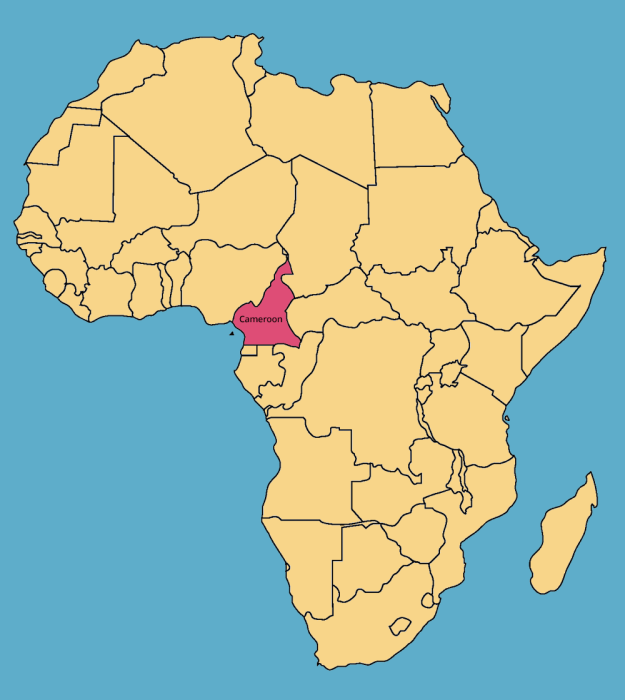September 2nd, 2014 by Rachel | Tags: Peace Corps | 1 Comment »
I have been saying all along that I’m heading to Cameroon but have neglected to give everyone an overview of the country. So few Americans and people from other parts of the world know so little about Cameroon as information about the country is rarely found in travel magazines and in the news. Therefore, I feel that it’s important for me to share facts so that people will understand better about the environment in which I will be living.
Cameroon, which is officially called Republic of Cameroon, is a triangular country that lies in west central Africa, bordered by Nigeria to the west and Central African Republic and Chad to the east. It is known as “Africa in Miniature” because it offers a taste of different climates and cultures and a great geographic diversity. It has deserts, jungles, mountains, savannahs and beaches. It has many of Africa’s iconic animals that we see on almost every cover of books about Africa, which includes elephants, giraffes, gorillas, hipopotami, rhinoceroses, and cheetahs. It is a home to 22.5 million people, making Cameroon the 58th largest country in the world, and over 300 ethnic groups of Bantu, Sudanese and Arab origins. While about 230 different languages are spoken, the official language of the country is English and French. Majority speak French. About half of the population is considered to be animist while about 30 percent are Christian and the rest is Muslim. There are 10 different regions which were once called provinces. Peace Corps volunteers are currently placed in eight of the ten regions. No volunteers are placed in the two northernmost regions due to the Boko Haram situation.

The present day of Cameroon was first settled during the Neolitic period, which is also known as the Iron Age, about 12,000 to 10,000 years ago. The Baka people, an ethnic group who primarily inhabit in the southeastern rain forests of Cameroon and a few other surrounding African countries, is the longest continuing inhabitants. Portuguese sailors then came to the coast of Cameroon in 1472 and discovered an abundant amount of shrimp in a river. Therefore, they named the river Rio dos Camarões, which means Shrimp River and became Cameroon in English. The origin of the country’s name is quite interesting! Then over the following hundreds of years, while more Europeans came to trade with people on the coast, Fula people, an ethnolinguistic group originating from both sub-saharan and north Africa, came to settle in the northern part of Cameroon. This group primarily spoke Fulfulde, which they still speak today. Shortly after Germans tried to colonize Cameroon during the 1800’s and Germany was defeated during World War I, in 1919, Cameroon, which was known then as a region called “Kamerun,” became a territory and was split with the French ruling most of the east side, about 80% of the country, and making their side known as “Cameroun” and the British ruling the west side and making their side known as “Cameroon.” The French area of Cameroon became independent from France in 1960 and then the British area of Cameroon united with the French area in 1961. Today, two of the regions primarily speak English and all the other eight regions primarily speak French. Peace Corps first entered in Cameroon in 1962 with 20 volunteers who worked in math and science education. Since then, more than 3,200 volunteers have served in Cameroon.
Cameroon’s biggest economic source is agriculture and about 80% of the population earn living from farming. Local foods include millet, beans, cassava, yams, plantains, sweet potatoes, avocados, mangoes, fish, and meat. Cameroon is the breadbasket for the region. While the literacy rate of Cameroon is about 77% for males and 59.8% for females, Cameroon has one of the highest literacy rates in Africa. The quality of healthcare is not so great which is why Peace Corps is after all sending volunteers to work in Health and also in Education, Community Economic Development and Youth Development.







1 Comment
Kristel
July 26, 2015 at 10:15 pm
Hi Rachel
Wow, what a great description of Cameroon! I’m from this beautiful country and I just wanted to let you know I appreciate your detailed description of my home. But I would like to add that actually we have more than 230 national languages. Following Tove Rosendal (2008, P. 17) there are 279 local languages in Cameroon. What a diversity, isn’t it?